Ever been convinced to try a new restaurant or buy a cool gadget after seeing a friend post about it online? That’s user-generated content (UGC) in action — and it’s one of the most powerful ways for brands to connect with audiences today.
A recent report found that UGC is 8.7x more impactful than influencer content, with 8 out of 10 people saying that user-generated content highly impacts purchasing decisions. Ultimately, when UGC is done right, it can build loyalty, drive engagement, and inspire new customers to take action.
But what are the different types of UGC you can leverage? And how can you inspire your audience to share? We’re breaking it all down.
What Is User-Generated Content?
User-generated content refers to any content — whether it’s text, images, or videos — created by individuals rather than brands. Unlike brand-generated content, which typically features polished marketing messages or promotional campaigns, UGC comes straight from those who use the products and services, ideally reflecting genuine experiences and opinions.
Some of the most common types of UGC include:
- Social media posts: Photos, videos, and comments posted by users on social platforms like Instagram, TikTok, Facebook, and YouTube.
- Reviews and testimonials: Feedback from customers that can be found on the brand’s website, app, or review sites like Yelp and Google.
- Blog posts and articles: Content written by customers sharing their thoughts and experiences with a brand or product.
- Creative contests: Entries from people who participate in brand-sponsored challenges or contests.
So, what makes UGC so appealing? For starters, it’s authentic. When consumers see real people using and enjoying a product, it resonates way more than a scripted ad would. As fatigue towards inauthentic advertising grows, user-generated content has become a way for brands to humanize their marketing efforts and earn consumers’ trust. Reflecting honest opinions and experiences, UGC has become a reliable source of information for potential buyers.
Why UGC Is Important for Brands
As we mentioned, UGC is a great tool for boosting trust. After all, a majority of consumers (86%) say that they’re more likely to trust a brand that publishes user-generated content. Even more, a lack of UGC can actually prompt distrust. 58% of consumers (including 64% of Gen Z and 60% of Millennials) reported leaving a brand website without purchasing because it didn’t contain any customer reviews or photos.
In other words, authentic content from real users isn’t just a nice-to-have but an expectation. With so many marketing messages competing for their attention, consumers crave relatable, real-world perspectives. By having real customers support the promise of a brand, UGC directly influences consumers’ purchase decisions. After all, when you see genuine stories and experiences from others, you’re more inclined to believe in the product’s value.
Beyond building trust, UGC also has the advantage of being cost-effective. Rather than producing all content in-house, brands can scale their content efforts by spotlighting user-generated photos, reviews, and stories. This not only saves time and money but also amplifies their reach with diverse content that resonates with a wide audience.
5 Ideas For Generating UGC
Since user-generated content is something you rely on others for, you might be wondering how to even get started. Luckily, UGC isn’t something that brands have to sit around and wait for. Here are five actionable ideas for getting your audience to create content for you.
1. Just Ask — And Make It Easy
Sometimes, all it takes to generate UGC is a simple ask! Encourage your customers to leave reviews and share photos or videos of your product on your website or social media. Make sure to keep the submission process simple and accessible to maximize participation.
E-commerce brands are masters at this. Their sites almost always include customer ratings and reviews directly under product listings with prominent “Add Your Review” buttons.
The fashion brand Everlane takes this idea a step further by also spotlighting customer-submitted photos on their homepage. By including a simple upload link, the brand makes it easy for fans to show off their style while letting new shoppers see the brand in action.
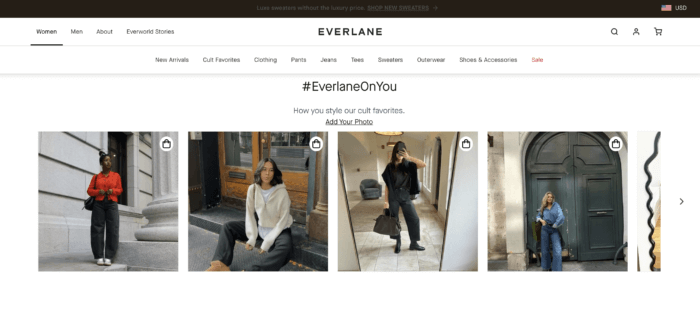
When customers see themselves featured — or believe they have a chance to be — it can inspire a powerful connection to the brand, often leading to greater brand loyalty. Give customers an easy way to share photos, videos, or reviews on your platform and you’ll be surprised at how much content your customers are willing to share.
2. Run a Branded Hashtag Campaign
You can also try creating a unique branded hashtag that encourages your audience to share their content. This gives followers a clear way to contribute while keeping all posts easily discoverable in one place.
Calvin Klein’s iconic #MyCalvins campaign is a great example of a hashtag that took on a life of its own. The brand sparked a global trend that continues to inspire UGC, with customers regularly using the hashtag when posting about their Calvin Klein products. In many ways, it’s turned into a badge of pride for fans, making them eager to show off their looks on social and beyond.
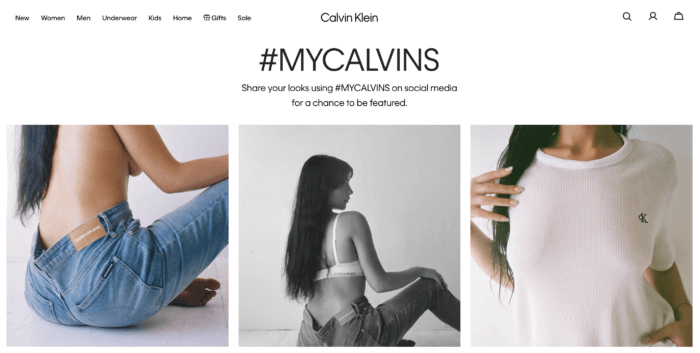
To replicate this, choose a catchy, easy-to-remember hashtag that represents your brand and pair it with a clear call to action. With a well-crafted hashtag, you can inspire your community to create content that showcases your brand in an organic way.
3. Hold Contests or Challenges
People love a good contest, especially if there’s a prize involved. Hosting a contest that requires user-submitted photos, videos, or stories is an excellent way to gather UGC while also boosting brand visibility. Incentivize participation by awarding the prize to the best submission. Just make sure to clearly outline the rules, encourage tagging your brand, and share the best entries to keep the momentum going.
For instance, GoPro regularly holds challenges as a part of its GoPro Awards program, inviting customers to submit their photos, raw clips, and edits filmed with GoPro products. Winners get anything from their equal share of $1 million to GoPro gear.
This UGC strategy has earned the brand some of its top-engaging posts, including the Instagram post below, which earned a 1.76% engagement rate by follower. That’s more than 4x higher than the median engagement rate across industries (0.43%)!
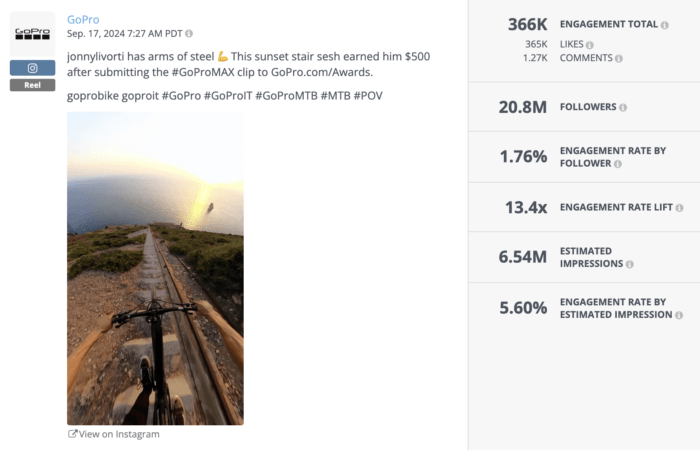
Of course, you don’t always need a grand prize to motivate participation. Getting featured on a brand’s social media is often enough to create buzz and encourage your audience to engage, such as with GoPro’s Photo of the Day Challenge, which boasts exposure to the brand’s massive audience of 44 million as the “prize.”
4. Partner With Influencers to Kickstart Participation
Collaborating with influential creators can be a powerful way to spark more UGC. By getting popular public figures to use your product, you set the stage for followers to get inspired and create their own content.
Apple’s #ShotOniPhone campaign is a perfect example. The brand regularly commissions artists to showcase what their devices can capture. Most recently, The Weeknd shot his Dancing in the Flames music video using the iPhone 16, sparking plenty of impressed reactions.
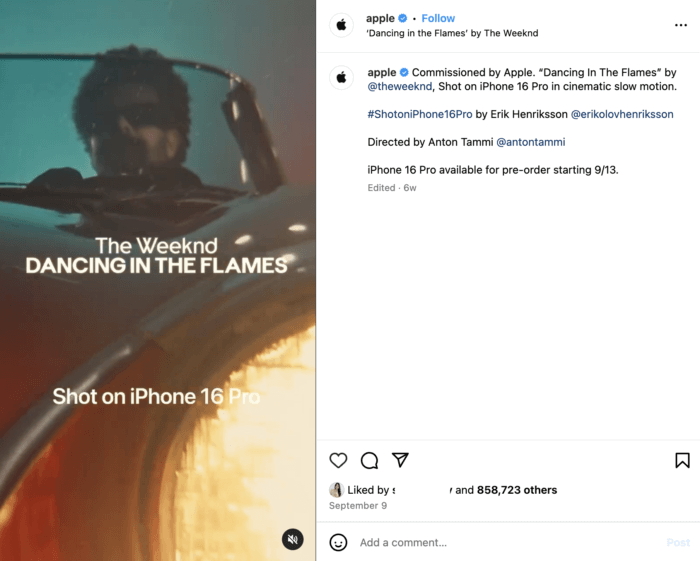
While a faceless brand might struggle to inspire genuine content from customers, a relatable and respected person can turn things around. You don’t even need to partner with a mega-star to make an impact. Micro-influencers can be just as powerful. With smaller but more engaged audiences, micro-influencers have a lot of, well, influence. By letting them kickstart the conversation, you can better convince users to join in and share their experiences.
5. Host a Shareworthy Event
Nothing makes people want to post like a fun experience. Hosting a pop-up event is a fantastic way to generate UGC while creating memorable brand interactions. Whether it’s an immersive experience with on-brand decor, interactive stations, or even a product trial area, a well-planned pop-up encourages attendees to snap photos, film videos, and post about the experience.
Take Glossier, for example. The beauty brand’s pop-up events often lead to posts by attendees eager to share their visits. A quick search of “Glossier pop-up” on TikTok results in numerous user-generated videos that spread the word and spur excitement.
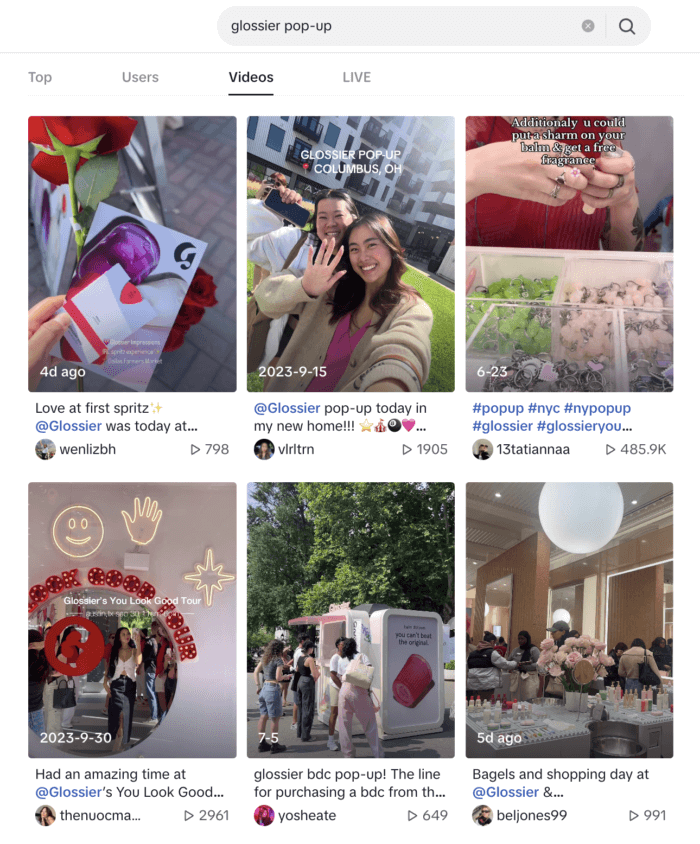
You can plan your own branded pop-up and encourage guests to post using a unique hashtag. Not only will you encourage plenty of UGC from event attendees, but you’ll also build stronger connections with your audience who get to experience your brand in a fun, shareable way.
Measuring the Success of Your UGC Campaign
The work doesn’t stop once the content is generated. You also need to keep an eye on your UGC campaign to determine if it’s resonating with your audience and supporting your brand goals. Tracking specific metrics will give you a clear view of how your audience is engaging and whether the campaign is driving the desired actions.
Start by looking at engagement metrics such as likes, reactions, comments, and shares. These interactions reflect how well the content is performing, with higher engagement suggesting that the posts resonate and are share-worthy. A social analytics platform like Rival IQ can help you assess this at a glance, letting you easily see how much engagement specific posts, hashtags, and even keywords are earning.
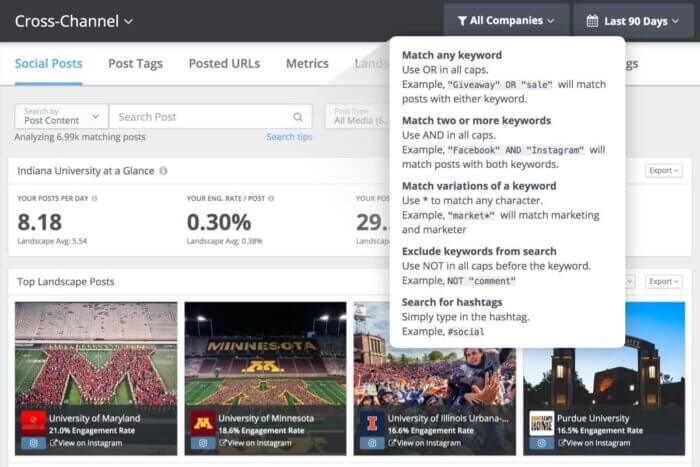
Beyond engagement, tracking website traffic and conversions from UGC posts is essential for seeing whether your content is actually driving people to take action. You can monitor this by using unique links or UTM codes within posts to trace specific traffic sources, or by checking your web analytics to see how users are interacting with your site after engaging with UGC. Analyzing these metrics can reveal how effectively it’s contributing to your overall goals and inform any changes needed to improve conversions.
Find out what is a good engagement rate on social media. 
Then there’s sentiment analysis, which is all about understanding the tone and emotions people express in their interactions. After all, it’s not just about the quantity of engagement but also their quality. Are people reacting positively or negatively? With Rival IQ’s social listening capabilities, you can track brand mentions, hashtags, and customer sentiment, letting you stay on top of your audience’s genuine reactions.
Wrapping It Up
From relatable videos to heartfelt reviews, UGC allows brands to showcase their products through the eyes of their customers. Embracing UGC means inviting your audience to be a part of your story, creating a feedback loop that not only boosts engagement but also drives loyalty. So, whether you’re just starting to experiment with UGC or looking to expand your current efforts, there’s no better time to tap into the creativity of your community.
